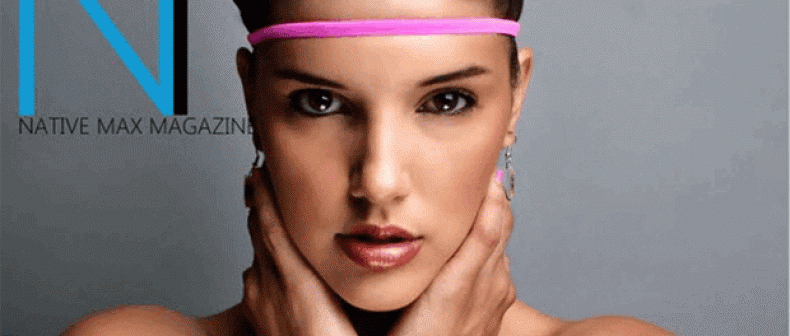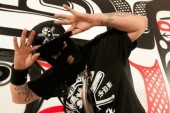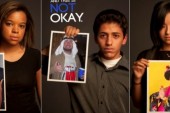
Another week, another feathered headdress scandal. First, the band No Doubt pulled their ‘cowboy and Indians’-themed video featuring Gwen Stefani as some kind of blonde Tiger Lily. (Given that the singer wore bindis in the 1990’s, Stefani has the distinction of appropriating styles from both East and West ‘Indians.’) This week, it’s Victoria’s Secret that had to apologize for sending model Karlie Kloss down the runway in a feathered headdress and skimpy lingerie.
The trend (sadly, we have to call it that) appears to have started a few years ago among white hipster girls who wore headbands with feathers as some kind of ironic fashion statement.
As Cherokee Native Adrienne K. writes, “Finger mustaches, PBR, Kanye glasses, old timey facial hair, 80’s spandex–fine, funny, a bit over-played, but ironic, I guess. Appropriating someone’s culture and cavorting around town in your skinny jeans with a feathered headdress, moccasins, and turquoise jewelry in an attempt to be ‘counterculture’? Not ironic.”
Then celebrities got into the act. Lana Del Rey, in her video “Ride,” traded in her crown of flowers for one of feathers. Rather than being ironic, Del Rey’s use of a feathered headdress was meant to evoke a mythologized American past of freedom and the open road. But nothing is without history. The thrust of westward-moving highways was only made possible by the removal and extermination of those who lived there first.
The look has filtered down to fast fashion chains’ “Navajo prints” that have nothing to do with the Navajo people. The Gap recently had to pull a t-shirt that featured the slogan ‘Manifest Destiny,’ the concept that the white man was fated to control all of North America. Do companies believe they are just as destined to appropriate any culture or tradition for their proud march of commerce?
I want to believe we’re more culturally sensitive as Canadians, but just because our pop stars aren’t dressed like Pocahontas (Carly Rae Jepsen, please don’t!) doesn’t mean we’re any better. At a Halloween party at the Garrison, I watched as a white guy received a lot of attention (and space on the dance floor) for his large feathered headdress, which he wore with a t-shirt and jeans. I lacked the courage to ask him about his ‘costume,’
It’s a difficult topic to bring up and everyone is rightly sensitive to charges of racism. I don’t believe most people who have worn feathers intend to offend. Trends are often started because we haven’t seen something in awhile. I can see why the Millennial generation, the first to grow up in a politically correct environment, might look at feathered headdresses and think they’re kind of cool. We didn’t play cowboys and Indians at school, so now we play it with fashion.
But feathered headdresses disappeared for a number of very good reasons: feathers are considered important ceremonial symbols for some Native bands; companies ripping off Native motifs, with no financial benefit for Native Americans, calls to mind the vast, ugly history of exploitation that Europeans used to take over the continent. By romanticizing the tribal, the trend situates Native Americans in the past, ignoring the fact that modern Aboriginals live in the present and have their own ideas about fashion.
It’s good there’s been there’s been pushback against No Doubt, Victoria’s Secret and the Gap, with each being forced to apologize and recant. Petitions and blogs like Adrienne K.’s have been effective in reminding everyone the myriad problems with this trend. (Gosh, I hope feathered headdresses aren’t being used by companies like Victoria’s Secret just to stir up controversy. That would be a new low.)
Being a critical consumer of the fashion industry is important, but there’s only so much we can do from the sidelines. That’s how Kelly Holmes, a member of Cheyenne River Sioux Tribe, felt as she flipped through fashion magazines. The 21-year old, who had already worked as a model, makeup artist, hair stylist and designer, decided to found a fashion magazine created for and by Native Americans.
“The founding philosophy for Native Max is to be equal and welcoming to all who are interested in being featured in the publication, and incorporate only Native talent into each issue,” writes Holmes in an e-mail interview. She explains that even though most of the magazine’s team no longer live on reservations, staying connected to cultural traditions is part of their mandate, while also covering mainstream trends.
Other purposes of the magazine, which has just released its first issue, are to promote diversity and correct misapprehensions about Native Americans. “With this magazine,” says Holmes, “we are resetting appropriations and letting our voices be heard and actions be seen. We are giving spotlights to talented Native Americans, Alaskan Natives and Canadian Natives.”
“We definitely don’t agree with Native American cultural appropriation being exploited in the music videos, runway shows and commercial photoshoots. In my tribe, along with other Plains tribes, headdresses are only worn by highly respected men who earn each and every feather…Headdresses aren’t a costume piece.”
I love that Holmes and her team realized what they were missing from the mainstream fashion media and set out to change it. The fashion industry can come across as run by a small clique of rich, white, skinny people (or even be boiled down simply to Anna Wintour), but it doesn’t have to be that way. The more voices the speak out about fashion, the more everyone’s understanding of personal style will grow. A lot of bad things get said about my generation, but because we’ve grown up expressing ourselves on online platforms, we don’t seek permission to grab the megaphone. We need to keep doing that without shame, especially if what we have to say hasn’t be heard before.
Although always a risky financial endeavor, I have great hopes for Native Max and magazines of its ilk. The feathered headdress trend traps Native Americans in the past; Native Max will usher in the future.
____
Max Mosher writes about style for Toronto Standard. You can follow him on Twitter at @max_mosher_.
For more, follow us on Twitter @TorontoStandard or subscribe to our newsletter.














